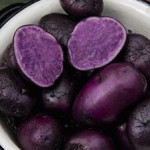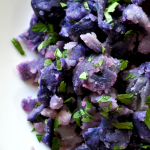It may come as a surprise to some, but potatoes are a very nutritionally rich food.
They are rich in important nutrients, antioxidants, resistant starch and other fiber — and they are one of the most filling foods for calories consumed.
There is some very good news about potatoes (it appears we have a new superfood) — and some very bad. You should take a few minutes to educate yourself to make better decisions.
The Benefits
One medium potato (5.3 oz) with the skin contains:
110 calories / no fat
Vitamin C – 45% of the daily value (DV)
Potassium (620 mg/18% DV) – more than bananas, spinach, or broccoli
B6 – 10% of the DV
Fiber – (2g) 8%
Trace amounts of thiamin, riboflavin, folate, magnesium, phosphorous, iron, and zinc
…and a lot more!
Satiety
Satiety is one of the most highly researched factors in weight management today. Satiety is defined as the physiological and psychological experience of “fullness” that comes after eating and/or drinking. It is the ability of a particular food to satisfy your hunger. Several studies have shown potatoes are among the most filling of foods for calories consumed. — and the feeling of fullness you get from potatoes lasts for hours.
While our salad mix is more filling with almost no calories, potatoes also rate near the top of the satiety index. The reason potatoes are so filling may be resistant starch.
Resistant Starch
Potatoes are one the best sources of natural resistant starch. Resistant starch acts like dietary fiber because it resists digestion in the stomach and passes through to the large intestine. Resistant starch is considered the third type of dietary fiber, as it can provide some of the benefits of both insoluble, and soluble fiber — including satisfying your hunger.
Like other types of fiber, resistant starch also has beneficial effects in the large intestine, the colon, as well as body wide. Health benefits in the colon include improved digestion and fermentation, the production of important short chain fatty acids, and increased production of “good” bacteria, all of which are believed to protect the colon from harmful microorganisms and even cancer. Body wide benefits include improvements in stabilizing blood sugar levels.
A United Nations/World Health Organization study concluded that resistant starch is “…one of the major developments in our understanding of the importance of carbohydrates for health in the past twenty years.”
Antioxidants
Out of 42 vegetables tested for total antioxidants, beans (including small red, kidney, black and pinto) ranked highest in total antioxidant capacity. However, russet potatoes ranked ahead of vegetables that are more commonly known for their antioxidant potential, such as broccoli, cabbage, and tomatoes.
Potatoes contain an assortment of phytochemicals with antioxidant properties, most notably carotenoids and anthocyanins. Anthocyanins are found in the greatest quantities in purple and red potatoes while carotenoids are found largely in yellow and red potatoes, although small amounts are also found in white potatoes.
Anthocyanins are considered to be among the strongest antioxidants. In addition to acting as antioxidants and fighting free radicals, anthocyanins may offer anti-inflammatory, anti-viral, and anti-cancer benefits. They are also associated with preventing inflammation, type II diabetes and cognitive decline — as well as allergy relief, better eyesight, heart health, weight loss, and ulcer treatment.
 A new level in antioxidants has been reached with Purple Majesty potatoes — bred at Colorado State University using traditional breeding methods. Purple Majesty potatoes have one of the highest anthocyanin content of any food available today — much above all other potatoes, including other purple varieties. The increased anthocyanin level is reminiscent of our ‘Indigo Rose’ tomatoes this past summer (bred by Oregon State University). The antioxidant capacity of ‘Purple Majesty’ anthocyanins is enhanced by proper cooking methods.
A new level in antioxidants has been reached with Purple Majesty potatoes — bred at Colorado State University using traditional breeding methods. Purple Majesty potatoes have one of the highest anthocyanin content of any food available today — much above all other potatoes, including other purple varieties. The increased anthocyanin level is reminiscent of our ‘Indigo Rose’ tomatoes this past summer (bred by Oregon State University). The antioxidant capacity of ‘Purple Majesty’ anthocyanins is enhanced by proper cooking methods.
The first study to check the effects of eating potatoes on blood pressure in humans has concluded that two small helpings of Purple Majesty potatoes a day decreases blood pressure by about 4 percent without causing weight gain.
We are happy to have organic ‘Purple Majesty’ potatoes in stock now (as well as seed varieties) — grown by one of the top organic specialty potato growers. This is a produce item that you will be hearing a lot about. It is exciting researchers and nutritionists alike — a modern marvel of traditional breeding methods with an ancient Peruvian ancestry.
When you use something so different in cooking, the  right recipe and presentation makes a big difference. I first had trouble using Green Zebra sauce until I stopped thinking of it as a green tomato sauce in traditional tomato sauce fashion and started thinking about the possibilities of a green sauce with a tomato flavor. Get creative and let us know what you come up with. A couple of cooking tips — lemon juice makes the dark blue more magenta and something like milk or mixing with white potatoes makes the color lighter.
right recipe and presentation makes a big difference. I first had trouble using Green Zebra sauce until I stopped thinking of it as a green tomato sauce in traditional tomato sauce fashion and started thinking about the possibilities of a green sauce with a tomato flavor. Get creative and let us know what you come up with. A couple of cooking tips — lemon juice makes the dark blue more magenta and something like milk or mixing with white potatoes makes the color lighter.
Potatoes are a very much underrated food. They are low calorie, nutrient rich, and are especially high in antioxidants and 3 different types of fiber. They have a 7,000 year tradition of nourishing and sustaining many generations. And, there are countless healthy recipes available for them. We made a really good — and incredibly unique — organic purple potato soup last week. We used Purple Majesty along with our organic heirloom fingerling mix in a great stew this week.
The Bad News
Potatoes are also a good example of what our big business food chains have done to our food. People can now buy non-organic potatoes that are ‘dirt cheap’ — but, here is how that happens.
Non-organic potatoes today are:
- Planted in less fertile soil than in the past — lowering nutrient content and quality. (e.g. Because of decades of potato monoculture in Idaho, many chefs now prefer Colorado or other potatoes to Idaho potatoes).
- They are fertilized with chemical fertilizers which contain few, in any, trace minerals — resulting in less healthy plants and less nutritious potatoes.
- They are treated with an array of pesticides while growing, necessitated by inferior health and lower disease resistance associated with chemical fertilizers.
- About 4 weeks before harvest, they are sprayed with chemical sprout inhibitors — which are really growth inhibitors that prevent cell division. These are sprayed on the foliage and absorbed into the potato tubers so the potatoes will not ‘sprout’ in storage at room temperature. This will not wash off since it is absorbed through the leaves into the tubers.
- 10-14 days before harvest, they are ‘sprayed to death‘ with an herbicide (usually Roundup) to toughen the skins (and improve storage). This is also sprayed on the foliage and absorbed into the tubers. Roundup also acts as a chelator of essential nutrients, making them unavailable to us. This will also not wash off since it is absorbed through the leaves into the tubers.
- They are often treated after harvest with post-harvest growth inhibitors.
- They are treated with a combination of preservatives to retard spoilage.
This is all done to increase shelf life for large retailers. I have talked to potato distributors who say that food chains will no longer buy untreated potatoes (except for organic which cannot be treated) Retailers want a long shelf life without refrigeration. The use of growth inhibitors — and preservatives is usually printed on the box to advertize the extended storage benefits to retailers (I see it all the time). However, it is information that most retailers neglect to tell you.
At Canterbury Creek Gardens, we believe in educating you so that you can make informed decisions about food choices. Where are the potatoes kept at your food retailer? — Why aren’t they sprouting? — and — What aren’t they telling you?
Ours are kept in a special dark cooler at 45-50 degrees to keep them fresh. At room temperature shelf life is much shorter for untreated potatoes — and kept in bright light, Solanine, which is a toxin, forms in potatoes. It has a bitter taste and can irritate the digestive tract.
Keep potatoes in a cool, dark spot in your refrigerator, or basement, etc. — best at 45-50 degrees. If kept below 40 degrees, the starches turn to sugars and cause other problems. If they are kept colder for a length of time, try bringing them slowly up to room temperatures to let the sugars change back to starches before cooking.
Chemically grown potatoes are inferior nutritionally; contain pesticides, growth inhibitors, and preservatives. Anyone who says that there is no significant difference between organic and chemically grown potatoes is either ignorant or misleading you. It is hard to tell which is worse.

Valuable information. Fortunate me I discovered your website accidentally, and I’m stunned why this twist of fate didn’t came about earlier! I bookmarked it.
Hello , you are awsome writer, i love your site